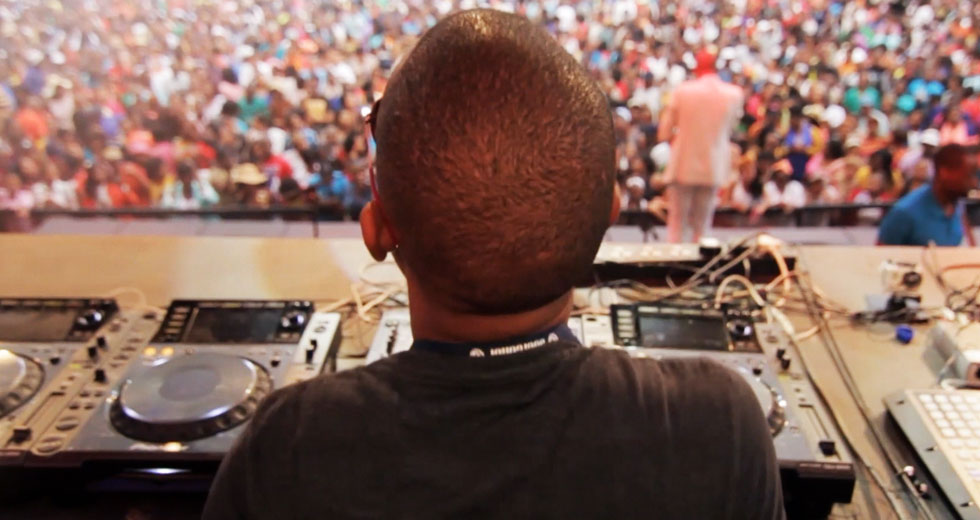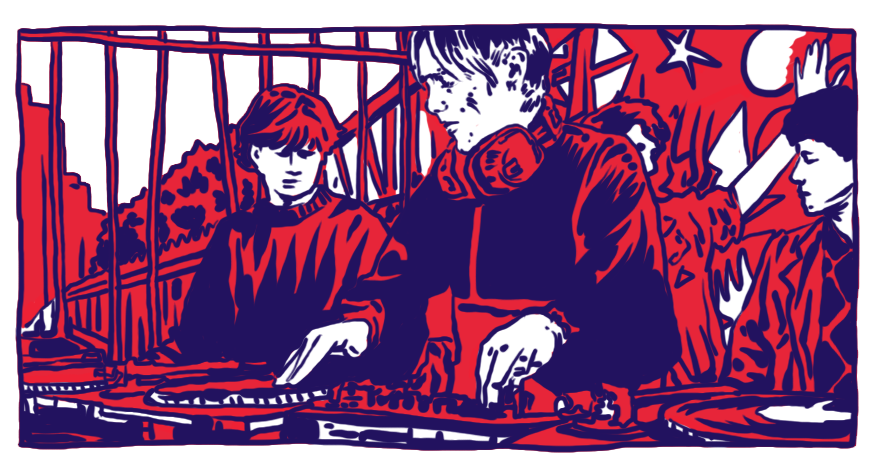Psytrance and Israel
Katie Bain explores the unique connection that one country has with the genre
It’s noon on a Sunday in an Israeli desert, and in the distance, across the brown, blasted terrain of the Holy Land, a party at a pirate ship is raging. It’s the fifth and final day of Midburn, Israel’s officially sanctioned Burning Man event. Roughly 8,000 people have descended upon the Negev desert to take part in the event’s promises of radical self-expression and communal bonding. The scene at once comprises the hedonism of Sodom and Gomorrah and the utopian visions of the Land of Milk and Honey, with vastly more hula hooping.
The past days have included the ritualistic burning of a full-sized arc, a traditional Shabbat dinner served by men in purple tutus and the relentless, omnipresent pounding of psytrance. No one has slept much, and everyone is covered with a thin layer of dust. But on the patch of dirt in front the ship – itself a stage featuring a huge soundsystem – a dozen ragged diehards are summoning the energy reserves of the truly devoted. They dance, swirl and stomp to psytrance’s rapid fire BPM, despite the fact that it’s 99 degrees and this party is technically over.
In Goa it was very underground, very tribal. It made me feel things I had never felt before.
To get to the root of Israel’s psy scene, one must first travel more than 2,600 miles southeast, to India. In the late ’80s, it became popular for young Israelis, freshly released from their mandatory military service in the Israeli Defense Forces [IDF], to backpack to Goa and its fabled Baga and Anjuna beaches. The living was cheap and the atmosphere was heady, fueled by marathon beach parties, psychedelics and Goa trance. One of the scene’s founders and best-known DJs was Goa Gil, a California expat who relocated to India, grew dreads, subscribed to Hinduism and played all-night seaside dance parties imbued with a sense of Eastern mysticism. Many backpackers stayed for months. Some stayed for life.
“There were no flyers [in Goa] and no one knew the lineup or even where the party would happen,” says longstanding Israeli psy producer Yuli Fershtat, who performs as Perfect Stranger. He spent two months in 1993 after serving in the IDF. “You just had to stop your motorbike, listen and go after the sound of the doof doof doof.”
“In Goa it was very underground, very tribal,” agrees Barak Argaman, who performs as one half of Israeli psy acts X-Noize and Major7. “For me it was all a new experience. It made me feel things I had never felt before.”
Thousands of similarly inspired Israelis returned home and went about expanding upon what they had experienced, transforming Goa trance into psychedelic trance – so named for the alien-sounding cosmic flourishes layered on top of the beat, as well as the LSD, mushrooms and other consciousness-expanding substances ingested at parties.
Parelleling the underground rave craze hitting the UK and United States, dozens of illegal psy parties materialized every weekend in the woods, beaches and deserts of Israel during the ’90s. Events were ecstatic, barefooted and often infused with a sense of spirituality summoned by the music’s trance-inducing properties (in conjunction with all the acid). When parties got busted, DJs were sometimes arrested while confused authorities confiscated PA systems.
“For the police,” says Argaman, “it was like something from outer space.”
Contributing to this “us vs. them” quality, many of these parties went down on traditional Israeli holidays and days of religious observation. Events started around midnight on Shabbat (the Jewish Sabbath), and lasted until the next afternoon, giving them what writer Joshua Schmidt calls a “quasi-religious atmosphere.” During this era, Israeli culture was generally becoming more secular, a phenomenon spurred by globalization and increasing influence from the United States in particular. Capitalism was on the rise, and 1993’s Oslo Accords created hope for peace after decades of Israeli/Palestinian conflict. Through psytrance, young Israelis both rebelled against the traditional rituals of their Zionist culture and simultaneously upheld the devotional nature of their forbears.
Israel is a special place, but it’s also full of stress.
Aggressive, complex and often lacking the traditional verse/chorus structure that makes other music easy to access, psy may have seemed an unlikely call to arms for generations of Israeli youth. Many say that it’s exactly these qualities that helped the music succeed in an area of the world where violence and upheaval have been part of the cultural DNA for millennia.
“Israel is a special place, but it’s also full of stress,” says Omri Homsy Harari, the founder of one of Israel’s first online psy magazines and a partner at Groove Attack, the promoter behind several of the country’s biggest psy festivals. “We’re always stressed. People need an outlet to find peace and rest in an extreme way.”
“People are running from their reality to these parties,” explains Argaman. “Israel is a very hot country. The music also represents our hot temper.”
As psytrance was soundtracking emotional catharsis for the thousands of Israelis journeying into the woods each weekend, the genre was also gaining traction beyond the underground. The Gathering, the 1999 debut LP from Haifa-based psy duo Infected Mushroom, was one of the first albums to bring psytrance to mainstream audiences. Astral Projection, a duo from Tel Aviv, was also pivotal in pushing the music to more listeners via popular mid-’90s tracks including “Kabalah” and “People Can Fly.” While Israeli radio was government-operated until 1990, by the end of the decade psy had a few designated time slots on local stations in Haifa, Tel Aviv and Be’er Sheva. Shows dedicated to the genre typically featured an hour-long artist interview and a second hour of that artist mixing in the studio.
According to Argaman, the definitive turning point in the scene’s commercialization came around 2008, when vocal tracks, previously unused in traditional “full-on” psy, became fashionable. This vocal trend helped evolve a more progressive style featuring lower BPMs, fewer psychedelic flourishes and less complex layering. With this, many longstanding producers, Argaman and his producing partner Nadav Bonen included, switched their focus to progressive psy, and the newly simplified genre became accessible for wider audiences.
Some, yours truly included, are concerned whether it is good that commercial crowds will participate in the underground movement.
The scene thus now exists in a tenuous balance. While underground parties still happen each weekend, there are also many legally sanctioned large-scale psy festivals including Unity and Groove Attack’s Neverland, which pulls a crowd of roughly 5,000 and will take place for the sixth time September 2016 in a rural area of northern Israel.
“In the last seven or eight years, everyone started going to these events,” Argaman says. “Even if you don’t like psytrance, it became fashionable to go to the parties.”
This spirit of inclusion doesn’t apply to the entire Israeli population. While Arabs and other minority groups are involved, non-religious Ashkenazi Jews make up the bulk of the scene’s organizers and participants. “It’s not like there isn’t room for Muslims,” Harari says, “but it’s a problematic question. I could never give a good answer.” While the Mukti Gathering pioneered Palestinian psy beginning in 2011, this scene has experienced limited expansion. Meanwhile, progressive psy, considered by some to be overtly cheesy, is now played in even the most mundane public spaces.
“I represent an artist named Bliss and I’ve been working for him with ten years,” Harari says. “He’s now doing university events, commercial company gatherings and weddings.”
As it goes anytime a scene explodes, some have their doubts. “Some, yours truly included, are concerned whether it is good that commercial crowds will participate in the underground movement, as that will render the underground useless,” says Fershtat. “That said, this is an inevitable progression, so we must take a leap of faith.”
Regardless of the bifurcation happening at home, Israel has been greatly influential in spreading psytrance around the world, especially after the rise of the internet. Psy is now huge in countries including Brazil, Japan, Serbia and Mexico, with Israeli artists headlining international events since their inception.
“I’m not saying only Israelis have contributed,” Harari says, “but there is no psytrance without Israeli psytrance.”
This worldwide influence continues now in both the underground and commercial realms. In August 2016, more than a dozen artists who played the main stage of Hungary’s O.Z.O.R.A. festival – which is respected as one of the world’s leading traditional psytrance gatherings – were Israeli. Israeli artists Astrix and Ace Ventura have played North America’s biggest dance music festival, EDC Las Vegas, and as Major7, Argaman and Nadav are booked to play this November’s Dreamstate, an ongoing all-trance show put on by EDC promoters Insomniac.
“The Israelis,” says Dreamstate booker Jeff Ryan, “are dominating the progressive psy movement here in the States."
“Progressive is going up in the United States,” Argaman agrees, “but it’s going down in many other places and the full-on is coming back. We still play as [progressive act] Major7, but I can play more underground X-Noize tracks these days than I could four years ago.”
As these cycles happen on the international circuit, the Israeli scene remains vibrant more than 30 years after its start. Whether the music is being played at a mall, festival or stretch of dirt in the desert, psychedelic trance endures as an intense genre for a complicated part of the world.

